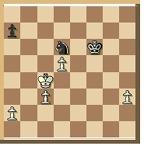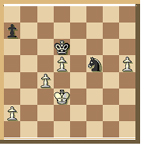The two positions below occurred at the Bazna invitational tournament in which six of the world’s top grandmasters participated. US grandmaster Gata Kamsky is playing White, and Romanian grandmaster Nisipeanu has the black pieces. In the first diagram, Kamsky plays 51. Kd4?? It is a mistake which costs him the win. The endgame from this point onwards is very interesting, and chess players can replay, and study it.
51.Kd4? After having analyzed the position , Kamsky found the solution: 51.Kc5 Ne4+ 52.Kb4!! A study like move designed to provoke the advance of the opponent’s a-pawn.
 a) 52.Kd4 Ng5 53.c4 Nxh3 54.Kc5 Ng5 55.Kb5 Ke5 is a draw; b) 52.Kc6 Nxc3 53.d6 (53.h4 Nxa2) 53…Ke6 54.a3 (54.a4 Nd5 55.a5 Nb4+=; 54.d7 Ke7 55.h4 Kd8 56.h5 Ne4 57.h6 Ng5 58.a4 Nh7 59.a5 Ng5 60.a6 Nh7 61.Kd6 Ng5=) 54…Nd5 55.h4 Nb6 56.h5 Nc4; 52…a5+ (52…Ke5 53.c4 Kd6 54.h4 Nf6 55.Kb5 wins) 53.Kc4! Nd6+ (or 53…Ke5 54.h4 Nf6 55.a4 Kd6 56.Kb5 Nxd5 57.c4 Nf4 58.Kb6 Kd7 59.c5) 54.Kc5 Ne4+ 55.Kc6 Nxc3 56.d6 Ke6 57.a3! It is important to take control over square b4! 57…Nd5 58.h4 Nf6 59.h5 and White wins.
a) 52.Kd4 Ng5 53.c4 Nxh3 54.Kc5 Ng5 55.Kb5 Ke5 is a draw; b) 52.Kc6 Nxc3 53.d6 (53.h4 Nxa2) 53…Ke6 54.a3 (54.a4 Nd5 55.a5 Nb4+=; 54.d7 Ke7 55.h4 Kd8 56.h5 Ne4 57.h6 Ng5 58.a4 Nh7 59.a5 Ng5 60.a6 Nh7 61.Kd6 Ng5=) 54…Nd5 55.h4 Nb6 56.h5 Nc4; 52…a5+ (52…Ke5 53.c4 Kd6 54.h4 Nf6 55.Kb5 wins) 53.Kc4! Nd6+ (or 53…Ke5 54.h4 Nf6 55.a4 Kd6 56.Kb5 Nxd5 57.c4 Nf4 58.Kb6 Kd7 59.c5) 54.Kc5 Ne4+ 55.Kc6 Nxc3 56.d6 Ke6 57.a3! It is important to take control over square b4! 57…Nd5 58.h4 Nf6 59.h5 and White wins.
51…Nb5+ 52.Kd3. White could still return to the winning path: 52.Kc4 Nd6+ 53.Kc5. 52…Ke5 53.c4 Nd6 54.h4. [54.c5 Ne4=] 54…Nf5 55.h5 Kd6
 In spite of having three passed pawns for the knight, White cannot make much progress, since 56.Ke4 runs into a check on g3. 56.Kc3 Kc5 57.Kb3 Nh6 58.Ka4 Kxc4 59.d6 Kc5. Draw agreed in view of 59…Kc5 60.d7 Nf7 61.Ka5 Kc6 62.Ka6 Kxd7 63.Kxa7 Kc7. Draw.
In spite of having three passed pawns for the knight, White cannot make much progress, since 56.Ke4 runs into a check on g3. 56.Kc3 Kc5 57.Kb3 Nh6 58.Ka4 Kxc4 59.d6 Kc5. Draw agreed in view of 59…Kc5 60.d7 Nf7 61.Ka5 Kc6 62.Ka6 Kxd7 63.Kxa7 Kc7. Draw.





